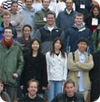Test2
From 2006.igem.org
Program History temp page
Program History
During MIT's Independent Activity Periods (IAP) of January 2003, student teams designed biological oscillators coupled to fluorescent reporters. These genetic blinkers were intended to improve on Elowitz's Repressilator. One team coupled two oscillators to even out the oscillations. Another used cell-cell signaling to coordinate the oscillators in a colony. During the January 2004 IAP, teams designed genetic systems to create cellular patterns varying from bull’s-eyes to polka dots and even dynamic designs where cells swim together. From these designs, standard biological parts were designed and synthesized.
Summer of 2004 brought the first Synthetic Biology Competition. Student teams from five schools (Princeton, MIT, Caltech, UT Austin, and Boston University) competed to build cellular state machines and counters. The teams came together for a jamboree in early November to compare their results. The most graphic project was "photographic biofilm" that could capture an image.
In the summer of 2005, student teams from thirteen schools (Berkeley, Caltech, Cambridge UK, Davidson, ETH Zurich, Harvard, MIT, Oklahoma, Penn State, Princeton, Toronto, UCSF, and UT Austin) participated in the 2005 International Genetically Engineered Machine (iGEM) competition. Later, during the first weekend of November, over 150 of these students, instructors, and PIs came together for a jamboree to share and celebrate their work.
The Igem 2005 student projects displayed the designs of chemotaxis regulation systems, cell-cell genetic communications systems, cellular/biological wires, thermometers, biological sketch pads (drawing systems), cellular relay races, a digital counter, and many more.
While at this early stage none of the projects were fully functional, many of the required subsystems demonstrated correct operation. Some of the student teams are continuing to work on their projects. One surprising result of Igem 2005 is that several of the schools have begun to incorporate Synthetic Biology into their undergraduate curriculum based on work from the 2005 event. Schools are now working on their iGEM summer 2006.
iGEM 2005
|
iGEM 2004
| |||||
2004 IAP
|
2003 IAP
| |||||
